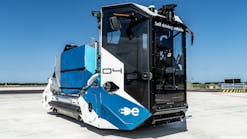The SAE’s AGE-3 Aircraft Ground Equipment committee held its spring 2024 meeting in Montreal in March. Throughout two days of productive discussions, breakout sessions and collaboration, committee members expressed their goal of increasing participation in the group, particularly with airlines and ground handlers.
“What we’re really looking for is people who want to engage and participate,” says Kevin Cecil, AGE-3 committee chairman and engineering manager, new product development at Oshkosh AeroTech.
There are three levels of AGE-3 committee member – voting member, liaison and mailing list member. Committee members participate in meetings – held twice a year, once in person and once virtually. Additionally, contributions outside of meetings, including reviewing, revising and commenting on standards is also required throughout the year.
“Voting members actively participate, by discussing, by voting,” Cecil says. “For everyone wanting to participate, being able to vote is a big reason behind attending.
“For those non-voting members, progressing towards becoming a voting member is key,” he continues. “After you’ve shown up for a long enough period of time, and you’re participating and showing you’re engaged, showing you have technical knowledge, then we want to help you advance into that voting piece.”
As the committee invites new people to the table, leaders noted the importance of striking a balance between producers (OEMs) and users (airlines and ground handlers) as well as other general interest members.
“We try to keep that mix between users and producers,” Cecil says. “We would like to bolster the number of users participating on our committees. So, we want to add users. We need some airlines and ground handlers to participate. With their contributions, we get a more balanced perspective and roster. That helps us produce really useful guidelines for the industry overall.”
Without the right balance of participants, Cecil notes a user could ask for something unproduceable, or a producer could create something that is unusable.
“But if you get both together, you should end up with a guideline beneficial for the entire industry,” he says.
By taking part in the creation, review and revision of standards airlines and ground handlers have the opportunity to gain an innate understanding of industry standards.
“It’s helping us engage, and making sure we have a safe product. The product is reliable, it has performance requirements that we need,” Cecil says. “While understanding the cost impacts as well.
“If we are all part of that group, with representation across the industry, we can make sure that language is fair to all,” he continues “I’d encourage users and producers alike to join us. If they, as a company, want to move forward and increase product levels of performance, safety, utility, whatever it might be, they can increase those by helping formalize the standards.”
Dan Boucher, vice chairman of the AGE-3 committee and president at PCS, adds that the committee can serve as an effective problem-solving body for the ground support industry.
“The producers may not see the problems that the airlines and the air handlers are seeing,” Boucher says. “I really would encourage more airlines and air handlers to participate because they’re the ones using it. I see it as ‘we’re here for them.’”
Presently, the committee’s voting membership consists of 14 producers, five users and three general interest individuals. Cecil notes re-engaging with users who may have had representation on the AGE-3 committee previously is key to striking a better balance across the group.
The AGE-3 committee will meet again this fall, holding a virtual meeting Sept. 5. Industry members who would like to join are encouraged to reach out. GSE subject matter experts can also contact the SAE AGE-3 committee or connect with current committee members for more information.









